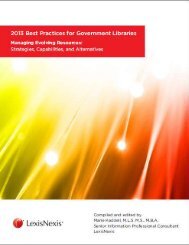2012 Best Practices for Government Libraries
2012 Best Practices for Government Libraries
2012 Best Practices for Government Libraries
You also want an ePaper? Increase the reach of your titles
YUMPU automatically turns print PDFs into web optimized ePapers that Google loves.
111<br />
BEST PRACTICES <strong>2012</strong><br />
Uncovering Human Trafficking in Supply Chains with LexisNexis Due<br />
Diligence Dashboard<br />
By Samir Goswami, CSR Consultant at G and C Consulting, Former Director of Corporate<br />
Responsibility, Rule of Law at LexisNexis<br />
When I used to visit my father at the Indian Embassy in Tripoli, Libya, the office<br />
compound was often flooded with desperate looking men in tattered clothing. They<br />
were sprawled out on the Embassy lawn, sleeping on the couches in the public<br />
areas, and showering in the bathrooms next to the receptionist’s desk. My father<br />
was a Diplomat and he told me that these were workers who were brought to Libya<br />
with promises of good jobs in the oil fields. However, once they got there they were<br />
often <strong>for</strong>ced to work <strong>for</strong> long hours with minimal pay in brutal conditions. Those<br />
camped out at the Embassy were able to get away and were awaiting repatriation<br />
to their villages in India.<br />
The oil they were <strong>for</strong>ced to extract and process was headed to consumers in<br />
Western markets.<br />
This was in 1985 and I was ten years old. Although at the time there were<br />
international labor conventions that recognized this <strong>for</strong>m of deception and harm, it<br />
was not until fifteen years later in 2000 that the U.S. Congress passed the<br />
Trafficking Victims Protection Act. The international community didn’t enact the<br />
landmark “Protocol to Prevent, Suppress and Punish Trafficking in Persons” until<br />
2003. Both of these measures define such elements of exploited labor as human<br />
trafficking and created comprehensive legislative frameworks to address the issue.<br />
GROWING INTERNATIONAL AWARENESS AND LAWS:<br />
The International Labor Organization estimates that out of 12.3 million <strong>for</strong>ced labor<br />
victims worldwide, around 2.4 million are trafficked and that as many as 1.2 million<br />
are children. Much of this labor goes to produce goods that we commonly consume.<br />
U.S. Department of Labor research indicates that <strong>for</strong>ced and child labor is found in<br />
a variety of sectors including agriculture, textiles, manufacturing, food processing,<br />
fisheries and commodities such as cotton, rubber and in the extraction and<br />
processing of rare earth minerals that are found in modern day electronics.<br />
Thus, U.S. and <strong>for</strong>eign governments have created a regulatory framework to ensure<br />
that we recognize and assist victims, punish traffickers and don’t inadvertently<br />
support human trafficking by utilizing <strong>for</strong>ced and child labor in the production of<br />
goods we consume. A few examples include:<br />
1. U.S. FAR Subpar 22.15: prohibition on federal procurement officials<br />
purchasing goods made with child labor.



